Dr. Lex' Micro Game Reviews
These are a bunch of succinct reviews of what I consider classic computer games that will remain enjoyable to play despite their increasing age. It may take some effort to run some of these games on recent hardware depending on your platform, but the reviews will offer some good incentives to try it anyway.
Long ago, I also made a comparison between a few older games from the mid-nineties, you can find this in the Marathon section of the site.
Deus Ex (2000)
What can I say? If I would have to pick the best computer game ever, this would be a very good candidate. Even from merely hearing the introduction song I get instant good memories of playing this game and a desire to play it again. Deus Ex has many shortcomings but it also brings forth many elements that were unseen in games that came before it and still were not commonplace by far in games that came ten years after it.
Deus Ex is at its core a first-person shooter, but it is much more than that. It adds RPG elements, an excellent and elaborate story with real depth, and it is highly nonlinear. Most other FPS games — especially the latest offerings at the time of this writing — are basically a long twisting funnel you need to blast your way through. Deus Ex is not. It is not a huge ‘sandbox’ game because it still has separate levels, but there are many different ways to accomplish goals within or even across levels, and decisions made in previous levels can affect the entire rest of the game's flow.
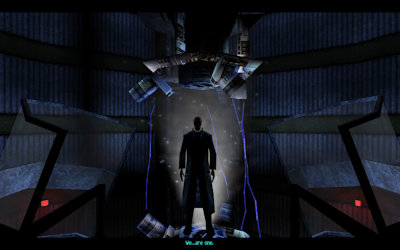
Deus Ex can be played a few hundred times without two of those sessions being the same. First of all, the game caters to many different playing styles. Although stealth is encouraged, it is also possible to just blast away. It is entirely possible to finish this game without killing anyone but you could also kill everyone and every dog, pigeon and rat if you wanted to. You can bribe a kid with a candy bar to get information, and then set him on fire with a flamethrower and take the candy back from his smouldering corpse. If other NPCs see you doing this, they may attack you or treat you as the lunatic you really are, but you won't be prohibited from doing it or be punished for it in some artificial way. This is one of the great things about this game: it does not enforce a particular playing style or even ideology upon the player. Some characters in the game try to, but not the game itself. This is also reflected in the three different possible endings that depend on the decisions you make in the final act of the game.
One of the things that make Deus Ex particularly cool are the ample opportunities to have political and sociological discussions with many of the NPCs. Again, although each character will have a certain opinion, overall you will never be pushed into a certain way of thinking. You can often drill down on the discussion topic by repeatedly activating the NPC. Even when the dialogue is over, the NPC will still give a few final remarks before starting to do the typical looping-NPC-dialogue-thing. Next to these live characters, you'll also find books littered all through the game, some of which will give you historical background or an entire story if you can find all copies. Of course you can skip all of these discussions and books if you want. They are not essential to finish the game. They do however add to the feeling of being inside a world that is more than just a long funnel-shaped shooting range.
Some have criticised Deus Ex for being too ambitious and trying to do stuff that was beyond the technology available at that time. While this may be true in some aspects, I believe they did a pretty good job overall. Games will always be limited in some aspect, and a good game turns those limitations into strengths. Nothing would be more boring (and potentially dangerous) than a game that is exactly the same as real life. Why the hell would I want to play that? I play games exactly to take a break from real life from time to time.
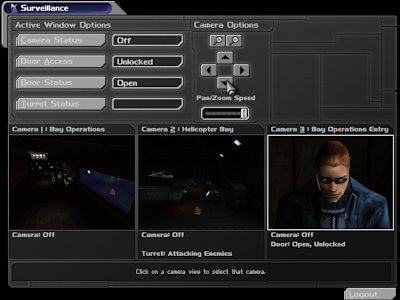
Deus Ex uses the Unreal engine, which was cutting-edge at that time. The game has excellent background music as well. The graphics still look OK today, but it would be cool if a re-release was made with an updated engine and refined models and textures. All the dialogue can be reused as-is, it is of excellent quality.
The bottom line: a true classic that offers many hours of immersive gameplay.
Max Payne (2001)
The inspiration behind ‘Max Payne’ may seem pretty obvious: the urban setting, bullet-time, guns, ringing phones, black-suited guys with sunglasses and earpieces… it are basically all the style elements from the 1999 movie ‘The Matrix’ turned into a game with a different story. The only un-Matrix-like element is the winter snow storm setting, which is this game's — admittedly plausible — excuse for the lack of crowds on the streets of New York. Max Payne isn't just a blatant Matrix rip-off however, because the game was already in a very advanced stage of development when the movie came out. The developers probably did adjust some things however after watching the movie…
Max Payne uses a combination of cut-scenes and graphic novel segments to propel its story. At the time of its release, games with a good story element were still rather rare and MP may be one of the driving forces behind the evolution towards games with more than just point n' shoot. The graphic novel idea works well and fits the game's ‘film noir’ setting. In fact, the most successful aspect of this game is how it constructs its setting and atmosphere. The story is secondary and a bit contrived. When one starts paying too much attention to the graphic novel parts, they tend to become slightly ridiculous because they are obviously trying too hard. It feels like every sentence was carefully crafted to contain as many film noir or graphic novel clichés as possible. Then again, the game doesn't always take itself seriously as evidenced by a few hilarious scenes half-way the play-through, hence the exaggeration might have been intentional. But overall it could have benefited from some extra polishing.
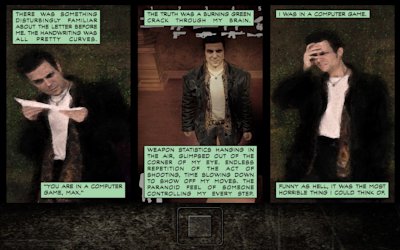
The funny thing is, the 2008 movie based on this game also spent so much effort on setting and atmosphere (quite successfully I must say) that they forgot about giving it a decent story. As with many video game adaptations, they didn't even bother to stay anywhere near the game's plot. If only they had done the logical thing by perfecting the game's rough story instead of further butchering it, the film could have been a lot better than it was.
Probably the most innovative feature of the game is ‘Bullet-Time.’ The player gains extra BT for each enemy killed and it drains while in use. BT can be engaged at any time, and like in the movies, it will switch everything to slow-motion mode. Next to being plain cool, bullet-time mode is essential to get through many of the battles in the game, especially in combination with jump and dodge moves. The player can still aim at full speed, giving an advantage over the slowed-down enemies. There is no armor, only a regular health meter heralds death when it reaches zero. To provide a hint of realism, the player does not re-gain health by miraculously absorbing medkits or roasted chickens. Instead, painkillers which can be collected and swallowed when desired, gradually refill the health meter (the recovery rate is slower at higher difficulty levels). Of course this still isn't realistic unless we assume that the pills also contain some mystery healing agent that prevents the main character from being turned into a hamburger by all the absorbed bullets.
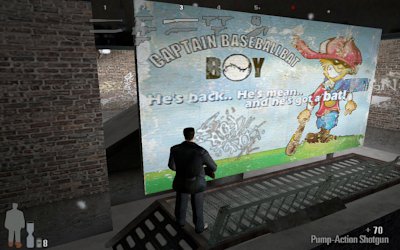
There are three difficulty settings, but the catch is that the game needs to be finished at the easier level before each harder one is unlocked. At the hardest level (Dead On Arrival), enemies can take a lot of hits while having a pretty good aim, and to top it off, the number of saves per ‘chapter’ is limited. A separate game mode, unlocked after finishing the easiest level, limits the amount of time per chapter. ‘Max Payne’ offers a pretty good amount of game time. It is long enough that even the third time you're playing it (with reasonable in-between breaks), you still won't know everything by heart. The sound design is excellent, attention has been paid to every detail like falling bullet shells and background noise in streets and buildings. Enemies will sometimes engage in funny conversations if you don't immediately jump from behind the corner to shoot them, and some TV sets play parodies of real TV shows.
The bottom line: a very cool game that makes up for trying too hard to be ‘film noir’ in its story dialogue, by nailing the atmosphere perfectly.
Prince of Persia: Sands of Time (2003)
This is a successful reincarnation of the classic 2D platform game that originated in 1989. It is obvious that Jordan Mechner and his crew did a lot of effort to bring the feel and gameplay elements of the original to this 3D version. Of course the extra dimension offers many extra possibilities but overall it feels surprisingly familiar if you've played the platformer, and that is certainly not a bad thing.
It is not just the game elements that make Sands of Time enjoyable. The entire story is well worked out with the help of both gorgeous graphics, sound design and music. With all graphics settings on max, it looks really good for a game from 2003. If you're not going to play this game multiple times for its puzzles and fights, then it will be to re-immerse yourself in the mysterious world that it presents. It also ends with a great twist that I will of course not reveal here. As with Max Payne, a movie adaptation was made (2010) but although Mechner was involved, it also failed to bring the potential of the game's story to the big screen and mostly dabbled in nice visuals and fighting scenes.
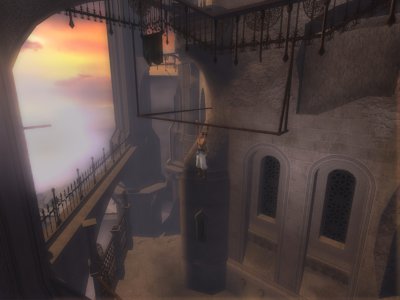
PoP:SoT features a ‘rewind’ system that allows to undo mistakes you've made within the last few dozen seconds (of which dying is the most obvious mistake). This is implemented through a dagger that you obtain in the very first levels of the game. This dagger must be recharged to refill the rewind ability, and is gradually upgraded through the game to offer more and longer rewinds. Even though you can only save at specific points, if you have run out of rewinds and die, you will most often be sent back to right before the last challenge and not the last save point, so you won't be forced to go through the same puzzles too often.
The only minus about PoP:SoT and unfortunately a big minus, is that the fighting tends to become tedious after a while and has a high risk of being frustrating. There is a rather limited set of baddies and they all have their own specific fighting style. Once you've figured out what moves to use against each type of enemy, the only difficulty is offered by their ever increasing numbers, the sometimes way too confined spaces, and the peculiarities of the combat system. It does not suffice to whack down the enemies, you must also ‘dissolve’ them with your dagger to prevent them from being revived (this is called “retrieving”). Quite often you will either be unable to do this because another enemy is standing too close and the game prefers stabbing live enemies with the dagger over retrieving, or you will be too busy avoiding getting mobbed. Hence there is a pretty large risk that you will have to ‘kill’ the same guy multiple times.
There are three things that make this even worse. First, each time you do a ‘retrieve,’ the rewind timer is reset. If you're killed right after retrieving, you cannot rewind and are instantly done for, even if your dagger was full. Second, each fight typically consists of two, three, and sometimes even four identical waves, with all enemies respawning after you have killed all of them. It all has a bit of a “lather, rinse, repeat” feeling. And third, I'm not entirely sure why, but most of the time my health meter was at the absolute minimum during the largest part of all fights. This may be due to a combination of all the above, and because I only wanted to use the rewind function when it was really needed, i.e. when I was dead. On the other hand, it doesn't really matter much how much you have left on your health meter. Once an enemy has whacked you down, it will most often deal multiple successive blows before you have any chance to recover. If you're surrounded by multiple enemies and are struck down, they will start to beat you up like a gang of hooligans and your health meter will plummet to zero in no time.
The bottom line: a very well-crafted game with the usual Jordan Mechner quality label. Play it for the puzzles, gorgeous graphics and atmosphere, not for the fighting mechanics which could have benefited from a lot more polishing.
Grand Theft Auto San Andreas (2004)
An impressive game featuring a huge ‘sandbox’-like environment. The area that the player can drive, run, and fly around in is about four times the size of the one in the previous GTA installment (Vice City), and is more detailed and interactive. The player can enter shops to dress up the main character, get him a haircut or tattoo, or eat some pizza or other fast food. There are even bars where a game of pool can be played, casinos with slots, blackjack, roulette and others. Small games-inside-the-game can be played on arcade machines which will even keep your high scores. Instead of one single city, there are three cities separated by a large stretch of countryside and desert. The cities are San Andreas, San Fierro, and Las Venturas, mimicking repectively Los Angeles, San Francisco, and Las Vegas. As in the previous GTA games, areas are only unlocked after completing certain missions, with the unlocking being implemented through vaguely plausible events occurring in the game world.
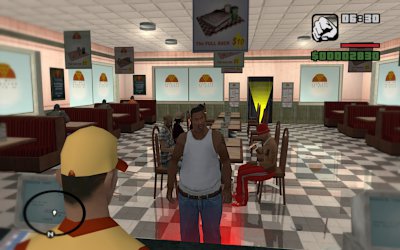
While GTA3 was situated in the year it was released (2001) and Vice City was situated in the 80's, GTA:SA is situated in the 90's. The story revolves around Carl Johnson returning to San Andreas for the funeral of his mother, and discovering that nothing is the same anymore. He has to re-gain respect from his family and former gang and ends up in lots of side quests involving corrupt cops, a mysterious secret agency guy, a die-hard hippie, and other characters. Like in the previous installments the story unfolds by means of different missions, which come in ‘chapters’ separated by key missions. Within a ‘chapter’ the order of the missions can be mostly chosen by the player. The overall story gives a more disjointed impression than in GTA: Vice City. Perhaps this is due to the larger scale of the entire game which probably required multiple teams working on different parts with limited intercommunication.
A trade mark of the GTA games since version 3, GTA:SA features built-in radio stations with music from the story's time period and hilarious fake commercials. The stations' running times seem to be further increased compared to Vice City's. Personally I think the music selection from Vice City was better, but this is probably a matter of taste. Unfortunately if one installs GTA:SA today from Steam, one will get severely butchered versions of the original radio stations, because the licenses on many of the songs have expired. There are ways around this and I recommend doing this extra effort to restore the radio stations even if it might be bordering on the edge of legality.
While the huge sandbox offers lots of possibilities for exploration and you may want to come back once in a while to play a game of pool or blackjack or just to behave like a lunatic and drive over the Las Venturas Strip sidewalk with a tank, the overall replay value is not very high. Once you've worked yourself through all the missions and taken over all gang territories, you've built up enough skill to make re-playing the game a tad too easy. A difficulty setting or different plot threads steered by choices at key points in the game, would have been a plus.
I have played the successor GTA IV but it didn't leave the same impression. While GTA:SA was still cartoonesque enough that it constantly reminded me I was playing a game, at some points GTA IV became all too real and gave me the impression I was actually doing morally wrong things. Even the player character seemed to resist having to perform some of the crimes. I don't mind acting like a criminal for the sake of playing a game, but I want it to remain just a game. If it becomes too much of a reality simulator, it is no longer fun to play.
The verdict: very cool and diverse game that will keep your attention for quite a while. The graphics may look dated, but the gameplay remains fresh.
Unreal Tournament 2004
The real sequel to the award-winning original Unreal Tournament. The 2003 version was more like an unfinished preview, 2004 is largely the same but with all the wrinkles ironed out and a few extras added. In these days of first-person shooters with elaborate storylines and characters, Unreal stands out as a no-nonsense shoot-'em-up. Some things have changed compared to the original UT, but most of the basic ingredients are the same: an arsenal of sci-fi weapons, quite challenging computer-controlled enemies, and of course lots of online gameplay options.
Compared to the original UT, there are two new gametypes that stand out. The first is Onslaught, where the goal is to make the enemy's “power core” vulnerable by forming a path of power nodes between your own power core and theirs, and then shooting it to smithereens. This game type adds vehicles to the gameplay, helping to cross the vast distances in the Onslaught maps and kill your enemies in other ways than with the classic set of weapons.
The other remarkable new gametype is Bombing Run, which could be described as soccer-on-steroids. There is a ‘ball’ which prevents the carrier from using any weapons but it provides a slow re-generation of health in return. The goal of the game is to score points by either shooting the ball in the enemy's goal, or jumping through the goal while carrying the ball (which is worth more points, but lethal in many of the levels).
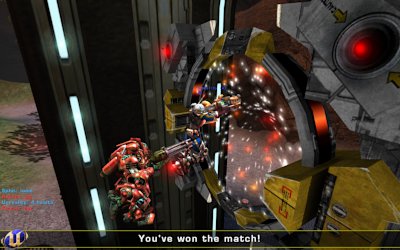
It is obvious that this game was made with multiplayer in mind. It does include a single player mode, conceived as a kind of team-based competition where one first needs to craft a team of computer-controlled players (‘bots’) and then use it to get to the final challenge. There is hardly any story here, it is obvious that single player is just meant to be a training ground for online play. There is a pretty frustrating discrepancy between the single player campaign and ‘instant action’ or server games. The skill level of the bots in SP will quickly rise far beyond the chosen level and especially the final opponent is almost unbeatable on any skill level without resorting to lame tricks.
Even in ‘instant action’ without auto-adjusting difficulty, it has to be said that the bots are a real challenge on the harder levels. Up to the ‘masterful’ level they mostly behave like realistic human opponents. On the hardest difficulties they start using obvious cheats and hacks. I know those difficulties are called “inhuman” and “godlike” but still it would have been much more impressive if the bots could beat me without speedhacking, wallhacking, and apparently spawning where they want (right in front of you while you're carrying their flag for instance). With speedhacking I mean that the bots move at an impossible speed as soon as no human player can see them (sometimes this detection fails, which is how I noticed it). Especially in Bombing Run and CTF, it is clear that the bots use these hacks to make up for their lack of strategic insight, which makes these gametypes frustrating when played against bots.
The verdict: still one of the best plain & simple shoot-em-ups. Just don't expect much of the single player mode. This game is made for online play hence only enjoyable when playing with teams of human opponents. If you want to really (re-)experience this game as it was meant to be, the hardest part will be convincing enough friends to install this ancient game and join in an online match.
Update 2024: actually the hardest part will now be to obtain the game at all. In a total dick move, Epic, the company that launched UT2004, is trying their best to make it impossible to install this game, as well as older installments in the Unreal series. I don't know what is the exact motivation behind this, perhaps they don't want to give people a point of comparison when figuring out how poor the gameplay is in contemporary games that mostly focus on fancy graphics only…
The Elder Scrolls IV: Oblivion (2006)
I am a sucker for RPG games, to such a degree that I generally avoid them because I know that once I'm sucked in, I will waste humongous amounts of time on them. Some friends managed to get me to start playing Oblivion, and the inevitable happened. I will not divulge how many hours, or better weeks or even months I spent in total in this game.
In many aspects, Oblivion has similarities with games like the GTA3 series: your game character also runs around like in a 3D shooter most of the time, and there is a global storyline consisting of missions that can be followed. In Oblivion however there are far more side missions than in GTA. There's an awful lot of things one can do that have little or nothing to do with the main quest. If GTA:SA is a sandbox, then Oblivion is an entire beach. Most of what I remember from playing this game has actually little to do with the main quest. I'm not saying the main story is boring, but in hindsight it seemed more like a vehicle to create the huge playground around it. In retrospect, the most memorable parts in Oblivion were from the Thieves Guild quest, so if you don't have the time to play this game entirely, make sure you do finish at least that storyline—if only because it involves actually stealing one of the scrolls mentioned in the game series' title!
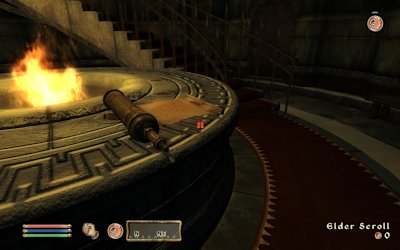
The biggest difference with a game like GTA:SA is of course that although the latter had a few RPG-like additions, Oblivion is a full-blown role-playing game with all the familiar whistles and bells like classes and skills that can be improved through various means. Many of the quests have a minimum requirement for skill levels. Something that bothered me though is that nearly everything in the Oblivion universe nicely levels up together with your character. The result is that you never really have the feeling that your character is evolving, save for the times where you punch one of the poor non-leveling creatures like rats or mudcrabs, and notice that it instantly dies instead of almost killing you like the first time you encountered one.
When I tried out its predecessor Morrowind years later, I found that it offered a much better sensation of my game character actually evolving. Overall though, although both games have their ups and downs, Oblivion feels like a more refined evolution of Morrowind. If you haven't played either of these games and want to try only one of them, I would recommend picking Oblivion. (If you do have time to spare however, I would obviously recommend first playing Morrowind and then Oblivion!)
At the time it was released, Oblivion was praised for its graphics and it does indeed look great. The downside was that one needed a pretty beefy machine to enable all bells and whistles. In my first playthrough I was actually unable to enable distant views at all, which resulted in the entire world being engulfed in a kind of eternal fog. It was only after I had a faster machine on which I could turn up the settings, that I discovered what I had been missing. On a present-day PC, one can play the game with pretty much all settings set to maximum.
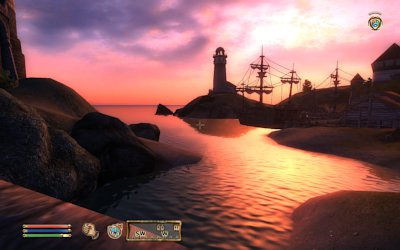
Quite a few expansion packs are available for the game, the most notable of which is Shivering Isles. It adds a huge new environment to the game with its own style and story, and is well worth playing.
The bottom line: the mere amount of time I have wasted in this game is a testament to how enjoyable it is. To keep it from consuming more of my time, I'll keep this review short. Oblivion is a great mix between a typical RPG and an FPS game. If you're a fan of both, be prepared to get sucked in.